Exploring the Blue Line Metro Route in Dubai
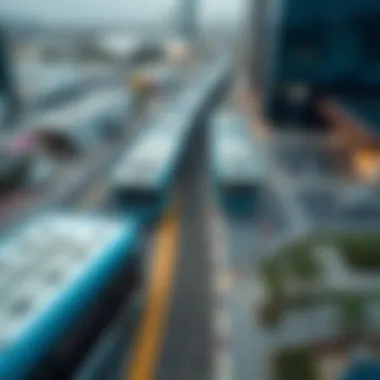
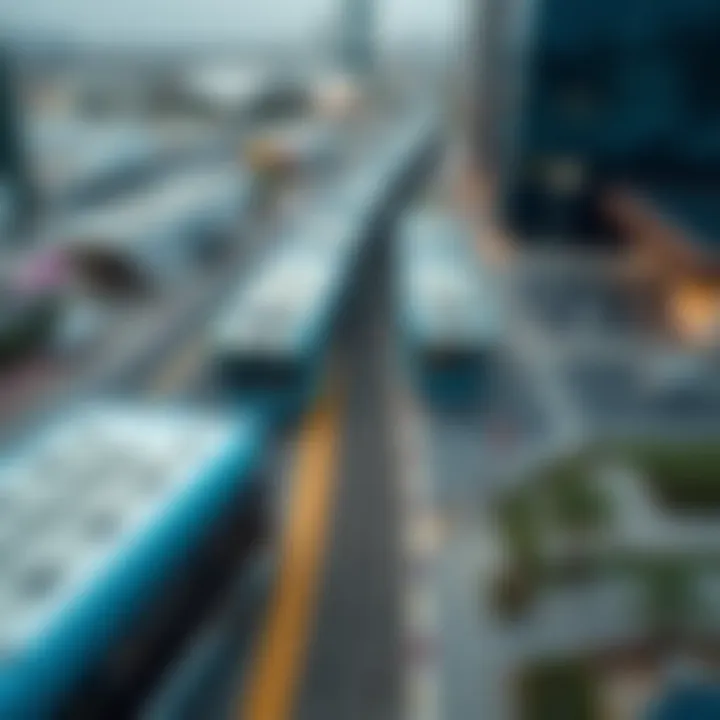
Intro
The Blue Line Metro Route in Dubai has quickly become a focal point, not just for commuters but also for real estate investors, urban planners, and those simply keen on the city's rapid development. This route extends beyond mere transportation; it opens doors to a myriad of opportunities and lifestyle transformations for inhabitants and businesses alike.
In a city characterized by its ambitious skyline and constantly evolving urban landscape, the metro system serves as the veins through which the life of Dubai flows. The Blue Line, in particular, connects diverse areas, offering insight into how the city orchestrates its growth and development.
By delving deeper into the nuances of this line, one can gauge its impact on the neighborhoods it traverses, the market trends shaping property values, and the lifestyle changes it brings to the residents.
Let's embark on this journey to unearth the significance of the Blue Line, particularly focusing on the emerging market trends and insights that cater to both investors and residents in this thriving metropolis.
Foreword to the Blue Line Metro Route
Dubai's metro system stands as a symbol of modernity and innovation, weaving through the city's vibrant landscape as an essential transport artery. Among its notable paths, the Blue Line Metro Route has emerged as a critical component, linking key areas and providing seamless connectivity. This article takes a close look at the Blue Line, exploring its significance, role in urban planning, and potential impact on real estate.
Overview of Dubai's Metro System
Dubai's metro system kicked off in September 2009, and since then, it has rapidly expanded, earning praise for its efficiency and coverage. The system boasts two main lines: the Red Line and the Green Line, with the Blue Line now carving its way through the city's core. With a fleet of driverless trains and stations equipped with cutting-edge technology, a ride on the metro enables passengers to glide above ground while watching the city unfold beneath them.
The metro connects several districts, catering not just to daily commuters but also to tourists who flock to Dubai's attractions. It's about quick access without the snarling traffic, providing a much-needed escape from the usual hustle and bustle. The metro also aligns with Dubai's long-term vision of becoming a sustainable, world-class city.
Significance of the Blue Line
The Blue Line has been designed to enhance connectivity between critical hubs, such as the airport and commercial centers. Its significance goes beyond mere transportation; it fosters urban growth, bringing life to areas that were previously underutilized. As it stretches across the city, the Blue Line facilitates movement, enabling better access to jobs, education, and leisure.
Particularly noteworthy is its role in economic stimulation. With an increase in foot traffic expected, businesses along the route stand to benefit from higher customer volumes. Moreover, potential investors and realtors need to pay attention; properties situated close to metro stations often see an uptick in value. It's the kind of ripple effect that can transform an entire neighborhood.
In a nutshell, the Blue Line is not just another route on the map; it's a blueprint for the future of urban living in Dubai, merging convenience with economic opportunity. As this article delves deeper, we will explore its route details, impact on urban development, and future prospects.
Route Details and Key Stations
Exploring the Blue Line Metro Route goes beyond mere travel; it's about understanding the intricate connections between various neighborhoods and the broader urban landscape of Dubai. This section lays the groundwork for grasping how each station contributes uniquely to the city’s transport matrix, enhancing mobility and accessibility for residents and visitors alike. Each stop along the route is not just a point on a map; it’s a gateway to diverse experiences and opportunities that help shape Dubai as a vibrant metropolis.
Starting Point: Rashidiya
Rashidiya marks the beginning of the Blue Line Metro Route, serving as a crucial junction for commuters coming from the east. This station is strategically located near residential areas and connects seamlessly with other transit options, making it indispensable for daily travelers. Its accessibility to major highways can’t be overstated, as it provides a vital link for those heading into the bustling city center or the more affluent areas. The station is characterized by its user-friendly design, catering to families and individuals alike. Amenities like retail spaces and waiting areas make it a comfortable starting point for anyone to embark on their journey across Dubai.
Intermediate Stations and Their Features
Al Qusais
Al Qusais stands out for its diverse community, mixing residential, commercial, and leisure spaces all in one area. The key characteristic of Al Qusais is its affordability in comparison to other neighborhoods along the route, making it an attractive option for families and young professionals. The proximity to various shopping centers and parks adds to its appeal. A unique feature of Al Qusais is the growing number of cultural initiatives, including art galleries and community events, which foster a sense of togetherness. While it enjoys popularity, potential downsides, such as noise from nearby roads, might be a downside for some.
Dubai Airport Free Zone
For many, the Dubai Airport Free Zone is synonymous with business and opportunity. Its main feature is its focus on attracting global companies, which makes it a pivotal node in Dubai's economic landscape. The ease of access via the Blue Line allows employees to travel between work and home with minimal hassle. A major advantage of this station lies in its proximity to the airport, offering unmatched convenience for business travelers. Despite its advantages, the area might present challenges in terms of housing availability, as demand often exceeds supply due to its booming business environment.
Union
Union Station is a vital hub where travelers can seamlessly switch to different metro lines, enhancing overall connectivity. Its highlight is the architectural design that reflects Dubai’s modernism while providing a functional transit point. This station is deeply ingrained in the city’s cultural fabric, with shops and eateries that reflect the cosmopolitan nature of Dubai. A significant feature is its spacious layout, which eases the flow of passenger movement, particularly during peak hours. However, the station’s central location also means it can become overcrowded, presenting a logistical challenge that authorities must address.
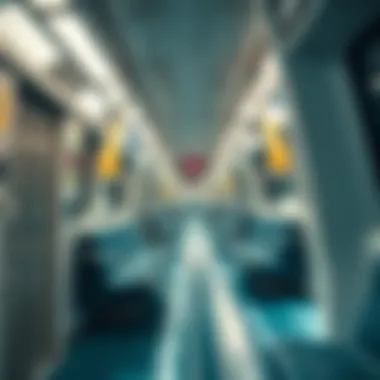
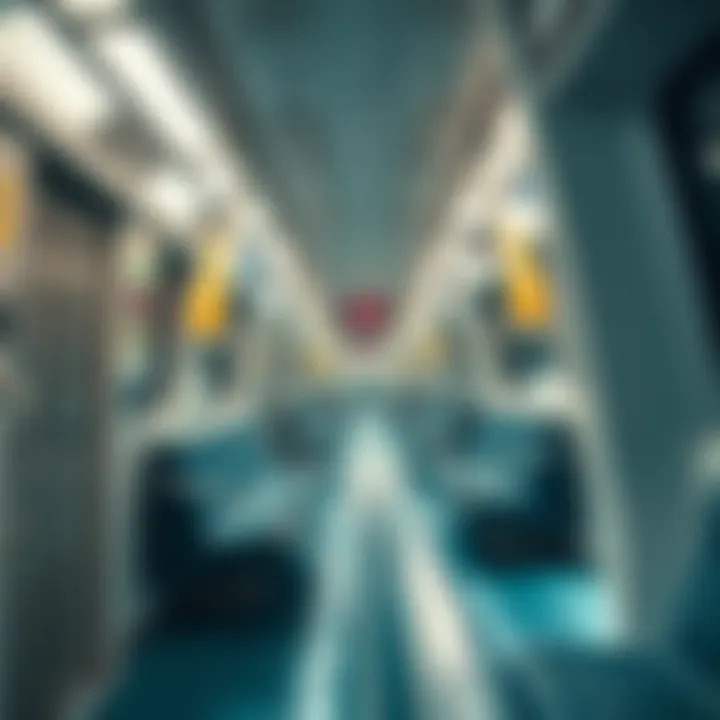
Al Karama
Known for its blend of tradition and modernization, Al Karama has retained its cultural heritage while adapting to contemporary needs. Key aspects include a vibrant marketplace offering everything from textiles to spices, making it a popular spot for both locals and tourists. Al Karama's proximity to the Blue Line makes it a practical choice for those wishing to retain a connection to their roots while enjoying modern conveniences. Unique aspects of the area include the close-knit community feel, although the increasing commercialization might detract from that charm for some residents.
Ending Point: Expo
The Expo 2020 station represents the culmination of the Blue Line’s route, symbolizing not only the end of a journey but the beginning of new opportunities. Located within the context of the Expo 2020 site, this station plays a crucial role in facilitating access to one of the world’s largest cultural exhibitions. The area has been designed to handle large crowds while providing easy access to various attractions. Its significance extends beyond transportation; it embodies the future direction of Dubai, showcasing advancements in technology, culture, and sustainability. This station, equipped with modern facilities, serves as a gateway not just to events but to a redefined urban experience.
Impact on Urban Development
The Blue Line Metro Route in Dubai is not just a means of transportation; it is a pivotal trigger for urban development throughout the city. It connects diverse neighborhoods, while simultaneously fostering economic growth, enhancing accessibility, and shaping the landscape of real estate. Understanding these impacts is essential for investors looking to navigate the shifting sands of Dubai's property market.
Connectivity and Accessibility
When considering the Blue Line's role in connectivity, one can see how it transforms the travel experience for residents and tourists alike. With stations strategically located in key areas such as Rashidiya and Expo 2020, the line facilitates easier commutes. This connectivity connects not just neighborhoods but also the various employment hubs around the city.
Residents now have the ability to travel within minutes to areas that traditionally required long drives or multiple bus transfers. It also promotes an environmentally friendly approach to urban transit, reducing reliance on personal vehicles and thereby cutting down on carbon emissions.
"Infrastructure shapes not just how we move but how we live."
Accessibility is particularly noticeable around commercial districts. Take the Al Qusais area, where the presence of the metro has made it a desirable location for businesses. The flow of foot traffic created by commuters lends itself to a vibrant retail scene—think cafés and shops bustling with activity, which boosts local economic health.
Commercial Development Trends
The commercial potential of areas surrounding the Blue Line is as significant as the line itself. New businesses are cropping up in response to the increased ease of access. Land developers are noticing trends towards higher commercial real estate values, particularly in stations like Union and Al Karama.
Amidst these developments, one observes:
- Rise of Mixed-Use Developments: Complexes that blend residential and commercial spaces are becoming common, offering a one-stop shop for work and leisure.
- Investment in Hospitality: With the metro directly linking to Dubai International Airport and Expo 2020, there's a surge in interest from hotel chains eager to capitalize on arriving tourists.
- Gentrification of Neighborhoods: Areas that were once considered solely residential are evolving into vibrant commercial hubs. This trend can be witnessed in Al Karama, which now features an array of dining and retail options.
Residential Property Value Changes
The changing landscape along the Blue Line has significant implications for residential properties. There's been a ripple effect regarding property values as neighborhoods become more interconnected through the metro. Investors are closely watching areas like Dubai Airport Free Zone, where accessibility translates into higher property demand and an uptick in rental prices.
In summary, the developments prompted by the Blue Line Metro create an intricate tapestry of urban transformation. Investors should take into account:
- Proximity to Metro Stations: Properties within walking distance of the line have seen appreciable value increases.
- Demand Surge in Rentals: As people flock to areas with improved access, rental prices tend to stabilize and grow steadily.
- Long-term Appreciation: The future looks bright for properties along the route, as enhancements continue to evolve, leading to sustained interest from buyers and renters alike.
Neighborhood Insights
In the ever-evolving landscape of Dubai, the neighborhoods near the Blue Line Metro Route hold significant importance. They are not just mere points on a map but thriving communities that knit together the city’s socio-economic fabric. Understanding these localities gives investors and residents essential insights into the lifestyle changes, opportunities, and the potential for future development. The neighborhoods along this route, particularly Al Qusais, Karama, and the Dubai International Airport area, present unique characteristics that contribute to the overall allure of living and investing in the vicinity.
Al Qusais: A Growing Hub
Al Qusais has emerged as a bustling hub that captures the essence of modern urban living while retaining elements of its traditional roots. This area showcases a growing blend of residential units and commercial establishments, making it an attractive option for families and young professionals. The presence of schools, parks, and dining options enhances its appeal, creating a vibrant community atmosphere.
One of the key growth factors for Al Qusais is its strategic location, which provides easy access to various parts of the city through the Blue Line. With continuous development projects underway, the neighborhood is witnessing a surge in property prices, drawing interest from both new residents and investors seeking long-term gains.
“The evolution of Al Qusais goes beyond just real estate; it's about building a community with a modern touch.”
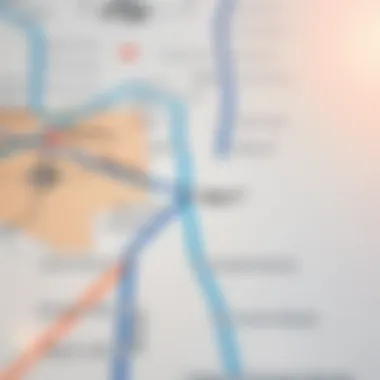
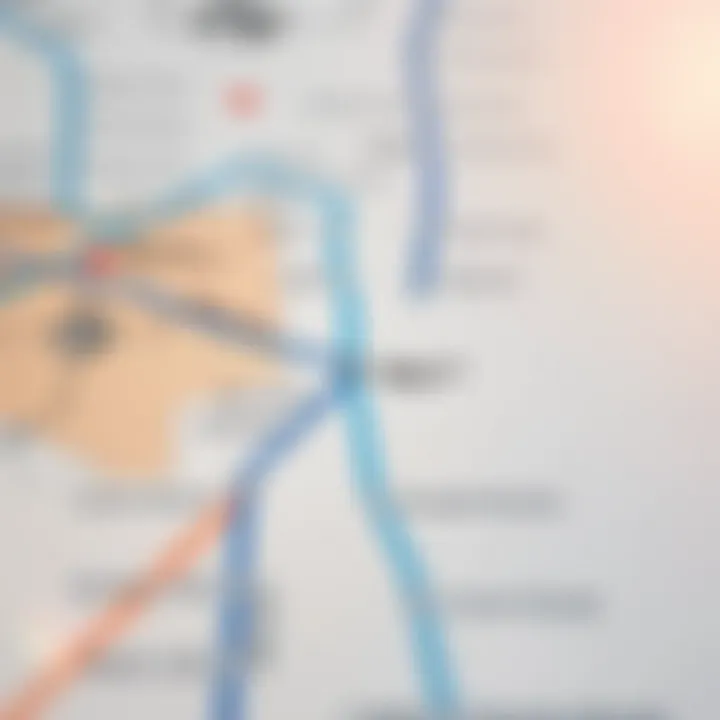
Residents benefit from a rich array of amenities, including healthcare facilities and recreational spaces. The neighborhood's blend of different cultures also contributes to its vibrant community spirit, making it a melting pot of traditions.
Karama: A Blend of Tradition and Transition
Karama stands out as a district resonating with cultural significance and charm. It is an area that has witnessed transitions over the years but still holds on to its traditional vibe. Known for its bustling markets and street food, Karama offers a unique experience different from Dubai's ultra-modern spaces.
This neighborhood's property market remains robust, with a blend of older buildings and new developments catering to varied demographics. The integration of the Blue Line has played a vital role in Karama's transition, enhancing connectivity without compromising its cultural heritage.
The area is exceptionally appealing for renters and buyers alike, providing options at diverse price points. New developments, including stylish apartments and commercial spaces, are cropping up, attracting young professionals who desire the thrill of a vibrant neighborhood filled with life.
Dubai International Airport Area: A Strategic Location
The area surrounding Dubai International Airport is undeniably one of the most strategically significant locations in the city. It creates an intersection between business, travel, and local life. Not only does it serve as a gateway for millions of travelers annually, but it also drives economic activity through tourism and business opportunities.
The proximity to the airport complements the Blue Line, making it exceptionally convenient for expatriates and frequent travelers. As a result, a variety of residential options have sprouted to accommodate the demand, including high-end apartments and more affordable housing solutions for airport personnel.
Strategically placed commercial establishments have also flourished, attracting business travelers looking for services and amenities at their fingertips. This area's growth is a testament to how public transportation can reshape an urban landscape to benefit residents, commuters, and investors alike, creating a dynamic environment.
In summary, the neighborhoods along the Blue Line Metro route—Al Qusais, Karama, and the Dubai International Airport area—demonstrate the various facets of urban living in Dubai. They not only elevate the convenience of transportation but also enhance lifestyle options. For investors and residents, understanding these local dynamics is crucial for making informed decisions in a competitive market.
Economic Implications
The economic implications of the Blue Line Metro Route in Dubai are multifaceted, intertwining socio-economic benefits with urban development dynamics. The metro system is more than just a mode of transport; it acts as a catalyst for growth. In particular, the establishment of the Blue Line has potential benefits that resonate across various sectors—employment, tourism, property values—creating a ripple effect that transforms urban living and investment landscapes.
Job Creation and Employment Opportunities
As the Blue Line expands, it opens up a myriad of job opportunities. The construction phase alone generates thousands of jobs for engineers, laborers, and project managers, contributing to local economies. Once operational, the line will create positions related to maintenance, security, ticketing, and customer services. On average, metro systems generate approximately 1.5 jobs for every million rides taken. This multiplier effect might lead to a significant rise in local employment, enhancing overall economic stability.
New businesses are likely to sprout around metro stations, offering everything from cafes to retail shops, thus further increasing employment prospects. Additionally, the higher foot traffic brought by commuters can make it feasible for entrepreneurs to invest in humble start-ups. In essence, the Blue Line does not just connect places; it connects people to opportunities.
Tourism Enhancement and Economic Growth
The Blue Line is poised to be a game-changer for Dubai's tourism sector. The seamless connectivity it offers between key attractions can entice more visitors to explore beyond the traditional tourist hotspots. Imagine a family landing at Dubai International Airport, hopping on the Blue Line, and quickly arriving at iconic destinations like Expo 2020. These not only enhance the tourist experience but also encourage longer stays, thus bolstering hotel occupancy rates.
Furthermore, a well-connected transport system can make Dubai a more attractive destination for international events and conventions, drawing in thousands of visitors. According to recent studies, cities with efficient public transport systems experience up to 30% growth in total tourist numbers. This factor cannot be understated—enhancing tourism leads to robust economic growth.
"A robust public transport network can transform an economy by boosting tourism, creating jobs, and encouraging urban development."
To sum it up, the Blue Line isn't merely a line on a map; it represents a transformative economic framework for investing in human potential and urban prosperity. It lays the groundwork for an enhanced quality of life while providing investors and stakeholders valuable insights into future possibilities.
Future Enhancements and Upgrades
As the Blue Line Metro Route continues to shape urban life in Dubai, its future enhancements and upgrades are pivotal. These improvements are not just about expanding the metro system; they reflect a commitment to progress and sustainability. In a rapidly growing city, adjustments must be made to meet the demands of a dynamic and diverse populace. Thus, planning for future enhancements is crucial, setting the stage for increased connectivity, greater efficiency, and a forward-looking transportation strategy.
Planned Extensions of the Blue Line
Currently, the Blue Line facilitates seamless travel across significant areas of Dubai, but plans are underway to extend it further. This extension aims to connect neighborhoods that have been historically underserved by public transportation. With these developments, residents can expect:
- Increased Accessibility: New stations will open doors for those living in outlying districts.
- Time Savings: Longer stretches of the Blue Line will cut down travel times dramatically.
- Economic Growth: With better connectivity, businesses near new stations may flourish, attracting investments.
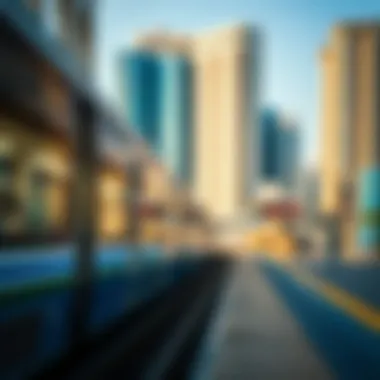
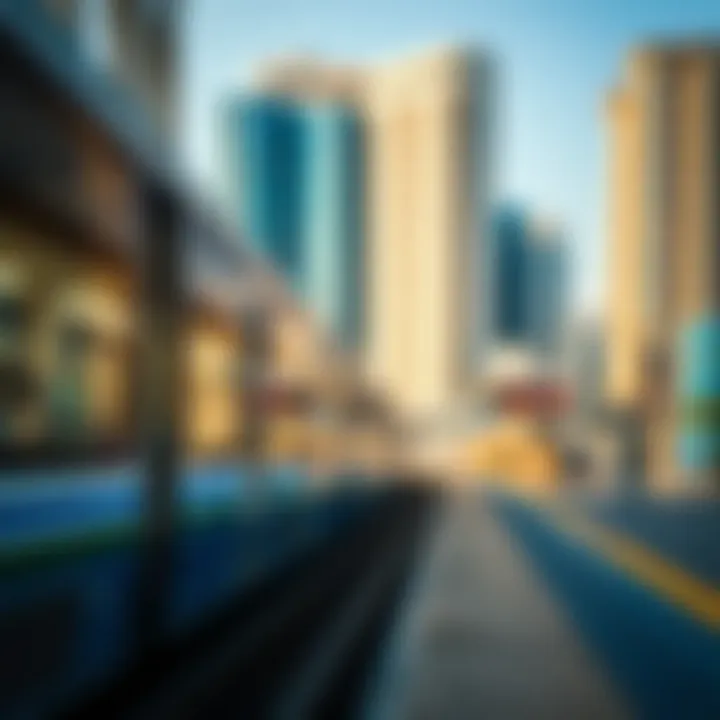
A notable proposed extension stretches towards areas like Dubai Marina, enhancing the overall network connectivity with existing metro lines. Such moves are set to amplify the significance of the Blue Line in light of Urban Mobility 2040 plans outlined by the Dubai government. This initiative clearly indicates that broader access to public transport is a key focus as Dubai aims for sustainable urban development.
Technological Improvements in Transportation
The introduction of new technologies on the Blue Line is another crucial aspect of its evolution. The intent here is to improve efficiency, safety, and the overall commuter experience. Significant upgrades include:
- Smart Ticketing Systems: Mobile applications for seamless fare payment will cater to tech-savvy travelers.
- Real-time Information Displays: Enhanced communication systems will ensure passengers are constantly updated on train schedules and potential disruptions.
- Sustainability: The integration of energy-efficient trains that reduce carbon footprints aligns with global sustainability goals.
With each of these enhancements, Dubai’s metro system stands not only as a mode of transport but as a model of modern infrastructure development. The Blue Line's journey seems like it’s just begun, with changes that could eventually make it indispensable to both residents and visitors.
"The future of urban transport in Dubai depends on the adaptability of its metro systems to cater to a growing urban population and an ever-evolving economic landscape."
Investors, developers, and users alike should closely watch the unfolding plans, as they hold the key to future prosperity and ease of movement within this bustling metropolis.
Challenges and Considerations
The expansion of the Blue Line Metro Route in Dubai marks a significant step in urban development and public transportation. However, as with any major infrastructure project, challenges and considerations arise that merit attention. Understanding these elements is crucial for investors, realtors, developers, and future residents who rely on the metro for commuting and connectivity. This section explores the construction impact on nearby neighborhoods and the essential sustainability and environmental issues that come into play.
Construction Impact on Neighborhoods
The construction phase of the Blue Line Metro involves a myriad of activities that can both benefit and hinder local neighborhoods. The first point to note is the disruption. Heavy machinery, noise, and dust can create a less than ideal living environment for those in proximity. Residents in areas like Al Qusais or Al Karama may feel the strain as construction crews work tirelessly to complete the necessary groundwork.
Yet, amidst these disruptions, there exists a silver lining. Development efforts can lead to better infrastructure, improved roadways, and increased accessibility to vital services. This juxtaposition of short-term discomfort against long-term benefits complicates community sentiment.
For example, as new stations emerge, they may invigorate local businesses, spurring economic growth. In places like Karama, small shops and food stalls may enjoy increased foot traffic, thus bolstering their revenue streams. People often say, "Every cloud has a silver lining," and this holds true as families may ultimately find themselves in a more integrated urban area.
Sustainability and Environmental Concerns
If any construction project hopes to thrive in today's conscientious society, sustainability must be at the forefront. The Blue Line has the potential to alleviate traffic congestion and reduce carbon emissions by promoting public transport over private vehicle use. However, the environmental footprint during construction requires careful management.
During construction, various ecologically sensitive areas could face threats. For instance, water drainage and soil erosion must be monitored closely. Effective strategies should be adopted to minimize adverse effects, such as using sustainable materials and recycling construction waste where possible.
Moreover, stakeholders should advocate for green spaces around new stations. Green roofs and urban landscaping can actively enhance air quality and create spaces for community interaction. This not only benefits the environment but also improves the aesthetics of urban living; thus, creating communities that people desire to call home.
In summary, while the Blue Line Metro construction introduces several challenges, it also presents opportunities for growth and innovation. Balancing these elements is essential to maintain harmony in the urban fabric of Dubai. As the saying goes, "A stitch in time saves nine," acknowledging and addressing these challenges sooner rather than later will pave the way for a more sustainable urban future.
The End and Outlook
The Blue Line Metro Route serves as a vital artery within Dubai’s rapidly evolving transportation network. As we conclude this exploration, it's crucial to consider not just what this line signifies today, but also the future implications it holds for the city and its inhabitants. The Blue Line isn’t merely a way to get from point A to point B; it encompasses a holistic approach toward urban mobility, economic vitality, and societal development.
Summary of Key Points
In this article, several significant themes and insights have emerged regarding the Blue Line Metro Route:
- Integration within the Metro System: The Blue Line enhances connectivity across Dubai, linking key areas and promoting easier access to various parts of the city.
- Urban Development: It has spurred residential and commercial growth, leading to increased property values and new ventures in surrounding neighborhoods.
- Economic Contributions: The route has been instrumental in job creation and boosting tourism, thereby fortifying Dubai's economic landscape.
- Future Enhancements: Planned extensions and technological advancements are set to improve the efficiency and user experience of this vital transportation option.
Implications for Investors and Residents
For investors and residents alike, the Blue Line offers a myriad of opportunities and considerations. Understanding its growth potential can aid in making informed decisions:
- Real Estate Investment: Properties close to the Blue Line stations are likely to appreciate in value, especially as urban development continues. Investors should look into neighborhoods that are well-connected by this route.
- Enhanced Lifestyle: Easy access to public transport can significantly improve the quality of life for residents, reducing commuting time and connecting them to social, recreational, and job opportunities.
- Market Trends: Being aware of how transport access influences market trends can provide investors an edge in forecasting future property demands.
The Blue Line is not just a transit system; it encapsulates the evolution of Dubai in terms of living, working, and investment.
The outlook for the Blue Line is positive. With continued investment and community support, it will undoubtedly play a pivotal role in Dubai's future, shaping how people interact with their city. As infrastructure improves, both residents and investors can expect a richer tapestry of urban life characterized by convenience and connectivity.











